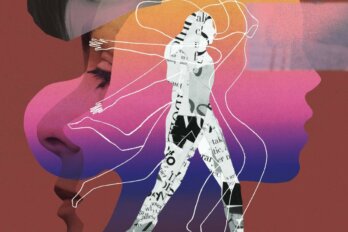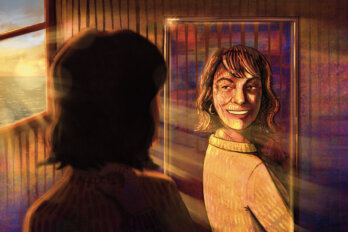The only time that the azan—the Islamic call to prayer that I’ve heard all my life—has truly frightened me was one evening four years ago, when it rang unexpectedly from my phone just as I was leaving the Legislative Assembly of Ontario. I was working as an usher in the home of Ontario politics, helping manage and maintain the institution’s decorum and traditions. After a five-hour shift, six of my colleagues and I were heading home via the Queen’s Park subway station just as the sun was setting over that gorgeous castle of a building. Everything was illuminated in a perfect soft Instagram-filter glow, and rush hour had slowed down to a pleasant hum as we walked and talked.
As a precautionary measure, my prayer app is always set to vibrate—an intense, impossible-to-ignore series of vibrations that buzz five times a day. But phones sometimes do mysterious things. On that day, mine decided to violate its human-set instructions. Loudly. Allahu akbar. Alllaaaaaaaaahhhh-hu-akbar.
Time suddenly stood still, as though my phone had burst into an obnoxious ringtone in the middle of a wedding service. My hands immediately began to rummage through my shoulder bag in search of the volume-down button on the phone that was inevitably buried at the very bottom. When I looked up, my colleagues were all looking silently at me, at my bag. I’d never wanted powers of invisibility or teleportation more. “What was that?” asked one of the boys. “Sorry guys,” I said, “it’s just time for the evening prayer, and my phone went spaz.”
I shouldn’t have apologized—there was nothing to apologize for—but the moment seemed to demand it. Actually, their slightly alarmed, confused looks seemed to demand it. I had inadvertently disrupted the peaceful evening with a sound that’s been deemed scary, traumatic even—the last words many victims likely heard before they were killed in terrorist attacks around the world. But I wasn’t a Muslim terrorist; I was just a Muslim, and my colleagues obviously knew that. They knew the distinction between the two. And yet that moment was deeply unsettling—for all of us.
My prayer app continues to be set on silent, even though these days, being Muslim is cool. In the past year, hijab-wearing women have been featured on the covers of high-profile magazines such as Playboy and Women’s Running and, most recently, Allure. Following the rise of American Olympic fencer Ibtihaj Muhammad, who was also the first veiled Muslim woman to ever appear on The Ellen Show, Nike generated social media traction when it announced a line of athletic wear tailored for Muslim women. Stephen Colbert has hosted every famous Muslim person on his show. Ms. Marvel is now a young Muslim-American girl—a superhero who struggles with her sense of self as she grapples with her faith and her superpowers. The glossy message, it seems, is that Muslims can be sexy, badass, and even liberated.
Around the world, non-Muslims have started to increasingly protect Muslims as they pray or break their fast in public places, from major international airports such as JFK to protest sites outside the New York Trump tower. If you attack Sadiq Khan, beloved Muslim mayor of the city of London, UK, you’re collectively told to “BACK THE F**K OFF.” And the phrase “Muslim ban” has galvanized a burgeoning movement of Muslims and non-Muslims alike that is supporting our freedom of religion and our right to belong like never before.
Meanwhile, in Canada, we have a prime minister who makes every Muslim swoon when he says “As-salam-walaykum” in his videos marking religious events such as Ramadan and Eid. The same prime minister has visited mosques, sat down for iftar, greeted Muslim refugee families at Toronto Pearson airport, and helped pave the way for anti-Islamophobia legislation across the country. Friday prayers still happen at schools despite community-led efforts to get Ontario’s Peel District School Board to dismiss them as “indoctrination.” October is nationally known as Canadian Islamic History Month, and has been since 2007. (Ontario declared October to be Islamic Heritage Month last year.)
With the exception of the occasional political stumble—a proposed niqab ban, a barbaric cultural practices hotline, immigration limits—Muslims are told they’re welcome in Canada. We have Calgary’s Naheed Nenshi, the first Muslim mayor in Canada and an object of almost universal adoration. And both the Aga Khan and Nobel laureate Malala Yousufzai have both addressed parliament, conferring their celebrity statuses onto the Muslim communities of any country they visit.
These combined gestures seem to point to a vast improvement over the associations that have plagued Muslims since 9/11. For years, the tired but still necessary trope that not all Muslims are terrorists has forced the community to identify as what we aren’t rather than what we are—and I, for one, have struggled to hold on to a secure sense of self. Too often, I’ve found myself formulating my identity in terms of how I differ from mainstream white culture: I don’t eat pork, I don’t drink alcohol, I don’t wear mini-skirts, I don’t date, and I pray five times a day, sometimes at a mosque.
Nowadays, magazine covers and government communications tell me that not only do those actions not make me a suspected terrorist—they’re to be celebrated. But here’s the really fine print: according to mainstream white culture, it’s okay to be a Muslim, but only if you’re the cool kind of Muslim—the Western Muslim. Fashionable. Current. Hip. Liberal. Relatable. Religious, but not too religious. You have to blend into society not by embracing your differences, but by minimizing them. Pray, but don’t flaunt it. Believe in God, but don’t air it.
These expectations have only strengthened the binaries of perceived Muslim identity. Muslim women are either oppressed or they’re badasses. They’re either victims of terror or soldiers against the patriarchy. Muslim men are either murderers or they’re heroes. Imams are either chauvinist dictators or inspiring faith leaders. I’m either . . . well, I don’t know.
“Just Muslim” isn’t a socially acceptable answer because my community is usually portrayed as one extreme or the other. That leaves little room in the public consciousness for Muslims who, like me, follow the scripture, but also love Harry Potter, listen to Drake, are LGBTQ allies, and fight rape culture. Because even if I am all these things, there’s a chance that someone will still attack me, verbally or physically. Just like seventeen-year-old Nabra Hassanen, who was killed last Sunday in Virginia after attending Ramadan prayers in her abaya and scarf. Or those at the Finsbury Park Mosque in London who were hit by a man in a van after the same prayers. Or, in my own country, those who were shot at a Quebec Mosque last January.
Being caught between binaries is not a new feeling. At school, I always used to slip away during lunch hour to pray. I had a list of excuses at the ready to justify leaving my friends: Bathroom break. Forgot to print my homework. Need to return a library book. Then I’d head to my locker, grab my abaya and scarf, and head to whatever obscure corner the school’s prayer room was hidden in.
Even though I grew up in Saudi Arabia and the United Arab Emirates, prayer rooms were an afterthought in the white halls of the British International schools I attended. In their original designs, no one thought that anyone at school would have need of prayer space. In fact, the rooms were only set up after an official ministry review in both countries mandated that every school should have one.
At my middle school, the prayer space was on the top floor at the back of the campus, accessible by a blue spiral fire escape. At my high school, it was near the cafeteria—an even bluer fire escape at the side of the building led up to a loft space above it.
The locations were perfect for a fourteen-year-old closet prayer who wanted to avoid the awkwardness that ensues when your mostly white classmates find out you pray. Awkwardness demanded that I justify and explain my actions in front of a jury that had already made a decision. It meant answering questions like, “Do your parents force you to?” or “Do you have to?” or, my favourite, “But why?” Being a Muslim was one thing, made respectable by the place we lived in, but being a fourteen-year-old Muslim girl who actually did Muslim things seemed bizarre—and, to some friends and coworkers today, that’s still the case.
As I got older, I tried to make my exits more natural, but I only became more apologetic. When we were hanging out at a friend’s house I’d ask to go to another room. “Sorry guys, I’m going to go pray real quickly.” If we were outside, I’d apologize for making a pit stop and pausing the fun. “Sorry, I just want to stop at the mosque real quick.” In order to be true to my faith, to be who I wanted to be, I felt the need to downplay my actions and ease any tension I might cause. Always, apologize.
I apologize because I realize I’m not represented in mainstream portrayals of Muslims—even those that stray from the clichéd terrorist. Think Aziz Ansari in Master of None—a self-identified Muslim man whose lifestyle seems entirely devoid of any Islam. In the Season Two episode “Religion,” he struggles to pretend to be a good Muslim when his parents invite him to Eid dinner with their friends. He usually eats pork, drinks, and doesn’t attend mosque—all habits his community wouldn’t approve of, and which his parents would prefer to keep secret. But that episode supposedly captures what the modern Muslim is expected to be: someone forced into Islamic traditions by the older generations in their family, but who actively disregards them.
Master of None is not the only show to erase my existence. I was excited when I first watched the hit FBI drama, Quantico, and saw that two of the characters are twin hijab-wearing Muslim female officers in the making. One seems more grounded in her Muslim identity than the other; she wants to wear the hijab while her sister does not. Their arguments about faith seem real, even bordering on nuance. The skeptic eventually removes her veil and becomes an integral part of high-level FBI operations. The other falls in love with a nice Jewish man; when he dies, she fades away from the central narrative, only to come back once or twice. The message, it seems, is that Muslim women can only attain heroine status when they defy their community’s traditions.
There’s nothing wrong with any of these portrayals. There is, after all, no one kind of Muslim. But such depictions recast Muslims solely in a western-friendly light, one that isn’t on my terms, and that continues to exclude me. Would it have been so difficult for the producers of Master of None to include a young person who, unlike Ansari, was actually trying to be an observant Muslim? Would fans have lost interest in Quantico if one of the twins were simply a practicing female Muslim FBI agent?
Then there’s real life. Think, for a second, of what happened in Portland and Manchester last month. Muslim members of the communities have come out in waves to prove they’re just as upset as everybody else, if not more. The headline of one Evening Standard report praises “The Muslim heroes of Manchester who rushed to help in the wake of the city’s terror attack.” The news of the Muslims who raised tens of thousands of dollars for the families of the Portland men who were stabbed to death while defending two young girls from a hate crime went viral. So did the unprecedented report that more than 130 Imams refused to perform funeral prayers for the terrorists of the London and Manchester incidents. So did the report of the Muslim who saved 64 Christians from being executed in the Philippines. Mayor Sadiq Khan earned accolades for saying that he is “a proud, patriotic British Muslim” and terrorist acts by Islamist groups are “not done in my name.”
Such pointed headlines and sound bites, and the positive social-media hot takes and retweets that accompany them, are only entrenching the binary further. They make me think I can only fit in by shunning tradition entirely—or, if I do practice my faith, I have to become a superhero to justify it. Until something changes, the only way I can validate my place in society is by winning Olympic medals, stuffing my face with bacon, or rescuing children from burning buildings.
Every Ramadan, my sister and I put on our abayas and headscarves and head to the mosque for the special night prayers. Growing up in Saudi Arabia, this was so normal to do, so natural—it was like a uniform for prayer, simple, smart, and decent. We’ve both mastered our individual hijab styles—hers is a little more spread out; mine is more fitted around the face. We’ve been wearing them for so long, we can put them on without looking in a mirror.
But it feels different here, today. “It must be scary for people here, you know,” my sister said one evening, “watching two girls in black abayas walking down the street.” For a moment, I felt hyper-aware of strangers’ reactions. All through the drive there, I wondered if the police car we had passed thought I looked suspicious, or if the family crossing the intersection was surreptitiously keeping an eye on us.
Some days my mom watches news coverage of the rising number of hate crimes aimed at Muslim girls and women, and worriedly tries to persuade me to wear the hijab full-time. “At least people will know immediately that you’re a Muslim,” she argues. “You’ll have a clear identity wherever you go.” Her point is that I’ll have more credibility—I’ll become an obvious card-carrying member of the community. She’s never pressured me to wear the hijab (it’s a choice; not a uniform); she’s simply acting out of concern. In a world that demands that I fit neatly into one category or another, maybe the hijab will spell out where I stand. No explanations or apologies needed.
But I shouldn’t have to change my habits to help shift the Western-accepted paradigm dictating how Muslim I get to be. Instead, people like me have to share their own stories, revealing the broad spectrum of Muslimness around the world.
If it’s cool to be the Aziz Ansari brand of Muslim today, the next step is to make it cool to be my kind of Muslim, too. The kind who chooses to pray and also chooses not to wear a veil. The one who finds solace in her faith and believes in Allah wholeheartedly. The kind who struggles with her identity, caught between two worlds, because that’s okay too.
This past month, I asked two event organizers and a restaurant employee for a space to pray. It was the first time I’d ever done it in Canada, and I was worried I’d have to explain myself—answer to the same unsettling looks my colleagues gave me four years ago. But all three happily obliged, without judgement or awkwardness. One of them took me to a storage closet in a back alleyway. But it’s a start.





